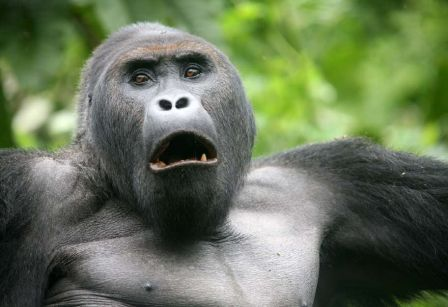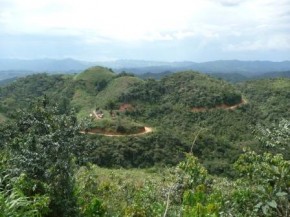To get to the other side, of course. Think of a silverback gorilla and a comparison with a lollipop lady probably isn’t the first thing that springs to mind. But on a road I visited this week in eastern DRC, the silverbacks play exactly that role.

In the Kahuzi-Biega National Park, humans and eastern lowland gorillas have coexisted since time began. And for many years, there has been a road running through 18km of the park, connecting the villagers to the markets and towns beyond.
The road crosses through two high altitude sections of the park – which is where the gorillas dwell. So a few times a week, they need to cross the road. And to do this, the silverback – the alpha male of the family – stands in the centre of the road to watch out for vehicles, pedestrians or perhaps poachers, and shepherds his family to safety.
I never thought my career would allow me to work on roads and gorillas at the same time. But here my responsibilities are split between managing the UK’s roads programmes in DRC, and making sure all of DFID DRC’s programmes avoid damage to the environment or climate – and deliver the best possible positive environmental and climate benefits.
Roads are essential to development, but if badly managed they can have a detrimental impact on the environment. In a country that is home to most of the world’s second largest forest basin, and where insecurity, isolation and lack of alternatives have led to a thriving trade in bushmeat, this risk is particularly pertinent.
To manage the environmental risks of our roads programmes effectively, and to maximise the positive impacts, we undertake ‘environmental and social impact assessments’ – the jargon for studies that identify the risks and opportunities and think through how to manage them. If environmental and social impacts don’t seem like obvious bedfellows, just think once more about the gorillas and the people in the park. Without a road, the villages are entirely cut off from markets, health services, schools and other essential services, meaning that opportunities for development are limited. Yet the road runs through the gorillas’ habitat – and eastern lowland (or Grauer's) gorillas are an endangered species, with just 4,000 individuals left. They are only found in the eastern forests of DRC. How do we balance these two incredibly important issues, to ensure not only that no damage is done, but that we get the best possible results?

I was in the east of the DRC to visit a road that DFID funded to reopen for the first time in over 20 years in December 2010, as well as the road through the national park, of which we’re funding the maintenance. We have just completed the environmental and social study for these roads, so part of my job was to see the reality on the ground and to make sure that our project partners put an effective system in place to manage the risks.
People in the area were involved in the study, and supported the idea of rehabilitating a road that bypasses the national park. Meanwhile, to ensure the villagers in the park don’t become increasingly isolated, their road will be rehabilitated only to a basic standard, so that the incentives are for all but essential traffic to take the bypass. We’ll also be looking specifically at how much trade in charcoal and bushmeat takes place in the region, before thinking through with the government, NGOs and local people how to ensure that they have not only a road, but a range of alternatives for gaining their income while protecting the environment.
I didn’t see the gorillas on this visit. But maybe one day – as we use our research and resources to get the balance right between their needs and people’s needs – I’ll get to see them safely making their way to the other side.

4 comments
Comment by Tahir Shakoor posted on
Great era, Environment friendly with the support of income generation and to address need, An excellent cause Vicky Seymour adhered with and as such it is above, By now i am seeing you to get to see them safely making their way to the other side.
Tahir Shakoor
Comment by Simon Jennings posted on
Hi Vicky,
Surely a limited re-grading of the road won't have much impact good or bad and it is overstating the case to suggest that there are big ecological and social questions hanging in the balance here? DfID is not advocating a massive new road that avoids the park along with a regional programme of socio-economic and infrastructure development, and/or abandoning the road completely, which might be in the long terms interests of the gorillas (and some of the more conservative indigenous people); or even building a new road through the park that is substantially better than the current one. Instead the compromise is to do a patch-up and regrade which will leave the road in such a poor state that only people who are unfortunate enough to live at the end of it will wish to use it! This implies that the real hope is that everyone will move out of the park - why not provide some incentives to attract them out as opposed to subjecting them to hardships that force them out?
I see "a census conducted late in 2010 in the highland sector of Kahuzi-Biega National Park revealed the presence of 181 individual Grauer's gorillas, compared with 168 detected in the same sector in 2004, according to a team led by the Wildlife Conservation Society." So if this is a discrete sub-population of gorillas within the larger eastern Congo metapopulation of a few thousand that you mention, the impacts of the roads on Grauer's gorillas would be intensely focused locally, meaning the effective time left for them is the time that it will take for a population of just a few hundred, not a few thousand, gorillas, to disappear from Kahuzi Biega.
I also read that this park is situated in "one of the most densely populated areas of the country where traditional livelihoods are based on shifting agriculture and subsistence hunting, and in the park there are ca 15 villages of shifting cultivators. "
It would appear that only some bold joined-up development (eg tourism revenues, access to markets and agricultural inputs, strengthened park management capacity and diminution of settlement in the park, difficult as there is probably nowhere for people to go) that relieves pressure on forest products and reduces local consumption of gorilla meat will help, and that's assuming a stable political climate. Otherwise surely a limited re-grading of the road is just fiddling while it all goes to hell in a handcart as Gerald Durrell once said.
In a different and less hard-edged ecological scenario - is it possible to advise if DfID is making any headway with the deliberations over the highway through the Serengeti??!
Sorry for the rant!
Thanks,
Simon
Comment by Vicky Seymour posted on
Many thanks for your comments, Simon.
In DRC, most roads have only been passable by foot or bike for the last 15-20 years. This means that even re-opening them to a basic level brings vehicles, trade and services along the length of the road that didn't exist previously - all of which can have an environmental and social impact. And this impact can be much broader than the more limited impacts of the physical infrastructure itself, so we need to take it very seriously indeed.
For this reason, all of DFID's programmes consider the broader implications of our investments - in terms of their economic, social, conflict, institutional and climate and environment impacts, for example. Investments in roads are not standalone interventions, but are linked into the Government of DRC's broader national development plan. Therefore, the kind of socio-economic development and support to park management institutions you allude to is considered hand in hand with the basic physical works part of our roads programmes.
Our DFID Kenya office should be able to tell you more about the Serengeti - do contact our Public Enquiry Point at enquiry@dfid.gov.uk.
Thanks again for sharing your thoughts.
Vicky
Comment by Vicky Seymour posted on
My apologies - the eagle-eyed among you will have noticed that the bit of the Serengeti in question is of course in Tanzania, not Kenya...